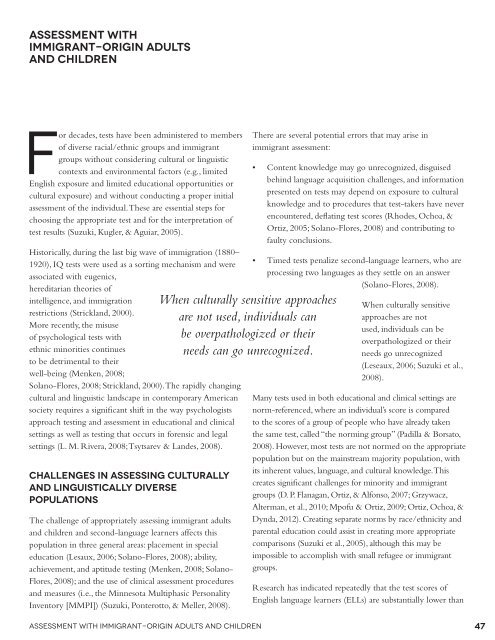Crossroads: The Psychology of Immigration in the New Century
Crossroads: The Psychology of Immigration in the New Century
Crossroads: The Psychology of Immigration in the New Century
Create successful ePaper yourself
Turn your PDF publications into a flip-book with our unique Google optimized e-Paper software.
assessment With<br />
Immigrant-orig<strong>in</strong> adults<br />
and Children<br />
For decades, tests have been adm<strong>in</strong>istered to members<br />
<strong>of</strong> diverse racial/ethnic groups and immigrant<br />
groups without consider<strong>in</strong>g cultural or l<strong>in</strong>guistic<br />
contexts and environmental factors (e.g., limited<br />
English exposure and limited educational opportunities or<br />
cultural exposure) and without conduct<strong>in</strong>g a proper <strong>in</strong>itial<br />
assessment <strong>of</strong> <strong>the</strong> <strong>in</strong>dividual. <strong>The</strong>se are essential steps for<br />
choos<strong>in</strong>g <strong>the</strong> appropriate test and for <strong>the</strong> <strong>in</strong>terpretation <strong>of</strong><br />
test results (Suzuki, Kugler, & Aguiar, 2005).<br />
Historically, dur<strong>in</strong>g <strong>the</strong> last big wave <strong>of</strong> immigration (1880–<br />
1920), IQ tests were used as a sort<strong>in</strong>g mechanism and were<br />
associated with eugenics,<br />
hereditarian <strong>the</strong>ories <strong>of</strong><br />
<strong>in</strong>telligence, and immigration<br />
restrictions (Strickland, 2000).<br />
More recently, <strong>the</strong> misuse<br />
<strong>of</strong> psychological tests with<br />
ethnic m<strong>in</strong>orities cont<strong>in</strong>ues<br />
to be detrimental to <strong>the</strong>ir<br />
well-be<strong>in</strong>g (Menken, 2008;<br />
Solano-Flores, 2008; Strickland, 2000). <strong>The</strong> rapidly chang<strong>in</strong>g<br />
cultural and l<strong>in</strong>guistic landscape <strong>in</strong> contemporary American<br />
society requires a significant shift <strong>in</strong> <strong>the</strong> way psychologists<br />
approach test<strong>in</strong>g and assessment <strong>in</strong> educational and cl<strong>in</strong>ical<br />
sett<strong>in</strong>gs as well as test<strong>in</strong>g that occurs <strong>in</strong> forensic and legal<br />
sett<strong>in</strong>gs (L. M. Rivera, 2008; Tsytsarev & Landes, 2008).<br />
Challenges <strong>in</strong> assess<strong>in</strong>g Culturally<br />
and L<strong>in</strong>guistically diverse<br />
Populations<br />
<strong>The</strong> challenge <strong>of</strong> appropriately assess<strong>in</strong>g immigrant adults<br />
and children and second-language learners affects this<br />
population <strong>in</strong> three general areas: placement <strong>in</strong> special<br />
education (Lesaux, 2006; Solano-Flores, 2008); ability,<br />
achievement, and aptitude test<strong>in</strong>g (Menken, 2008; Solano-<br />
Flores, 2008); and <strong>the</strong> use <strong>of</strong> cl<strong>in</strong>ical assessment procedures<br />
and measures (i.e., <strong>the</strong> M<strong>in</strong>nesota Multiphasic Personality<br />
Inventory [MMPI]) (Suzuki, Ponterotto, & Meller, 2008).<br />
When culturally sensitive approaches<br />
are not used, <strong>in</strong>dividuals can<br />
be overpathologized or <strong>the</strong>ir<br />
needs can go unrecognized.<br />
Assessment With Immigrant-Orig<strong>in</strong> Adults and Children<br />
<strong>The</strong>re are several potential errors that may arise <strong>in</strong><br />
immigrant assessment:<br />
• Content knowledge may go unrecognized, disguised<br />
beh<strong>in</strong>d language acquisition challenges, and <strong>in</strong>formation<br />
presented on tests may depend on exposure to cultural<br />
knowledge and to procedures that test-takers have never<br />
encountered, deflat<strong>in</strong>g test scores (Rhodes, Ochoa, &<br />
Ortiz, 2005; Solano-Flores, 2008) and contribut<strong>in</strong>g to<br />
faulty conclusions.<br />
• Timed tests penalize second-language learners, who are<br />
process<strong>in</strong>g two languages as <strong>the</strong>y settle on an answer<br />
(Solano-Flores, 2008).<br />
When culturally sensitive<br />
approaches are not<br />
used, <strong>in</strong>dividuals can be<br />
overpathologized or <strong>the</strong>ir<br />
needs go unrecognized<br />
(Leseaux, 2006; Suzuki et al.,<br />
2008).<br />
Many tests used <strong>in</strong> both educational and cl<strong>in</strong>ical sett<strong>in</strong>gs are<br />
norm-referenced, where an <strong>in</strong>dividual’s score is compared<br />
to <strong>the</strong> scores <strong>of</strong> a group <strong>of</strong> people who have already taken<br />
<strong>the</strong> same test, called “<strong>the</strong> norm<strong>in</strong>g group” (Padilla & Borsato,<br />
2008). However, most tests are not normed on <strong>the</strong> appropriate<br />
population but on <strong>the</strong> ma<strong>in</strong>stream majority population, with<br />
its <strong>in</strong>herent values, language, and cultural knowledge. This<br />
creates significant challenges for m<strong>in</strong>ority and immigrant<br />
groups (D. P. Flanagan, Ortiz, & Alfonso, 2007; Grzywacz,<br />
Alterman, et al., 2010; Mp<strong>of</strong>u & Ortiz, 2009; Ortiz, Ochoa, &<br />
Dynda, 2012). Creat<strong>in</strong>g separate norms by race/ethnicity and<br />
parental education could assist <strong>in</strong> creat<strong>in</strong>g more appropriate<br />
comparisons (Suzuki et al., 2005), although this may be<br />
impossible to accomplish with small refugee or immigrant<br />
groups.<br />
Research has <strong>in</strong>dicated repeatedly that <strong>the</strong> test scores <strong>of</strong><br />
English language learners (ELLs) are substantially lower than<br />
47
















